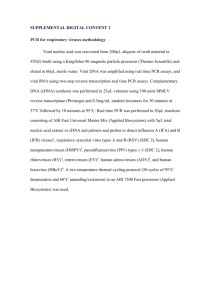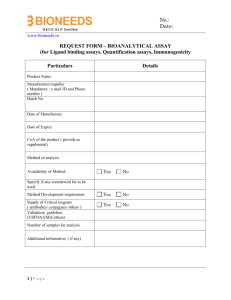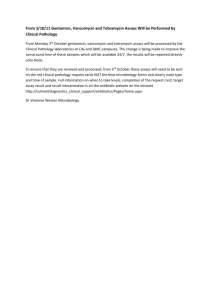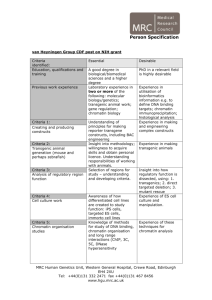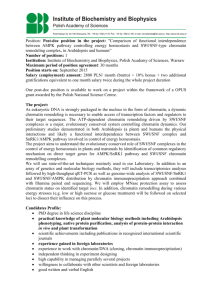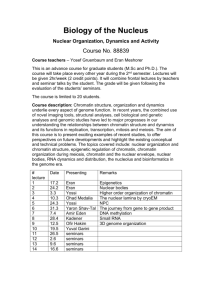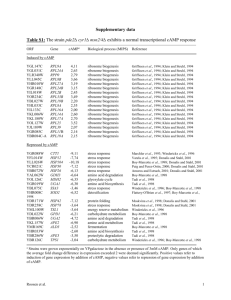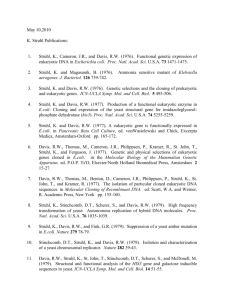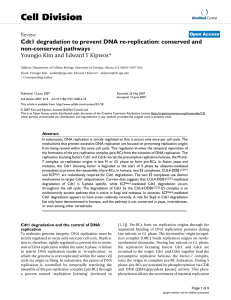MiottoSuppMat
advertisement
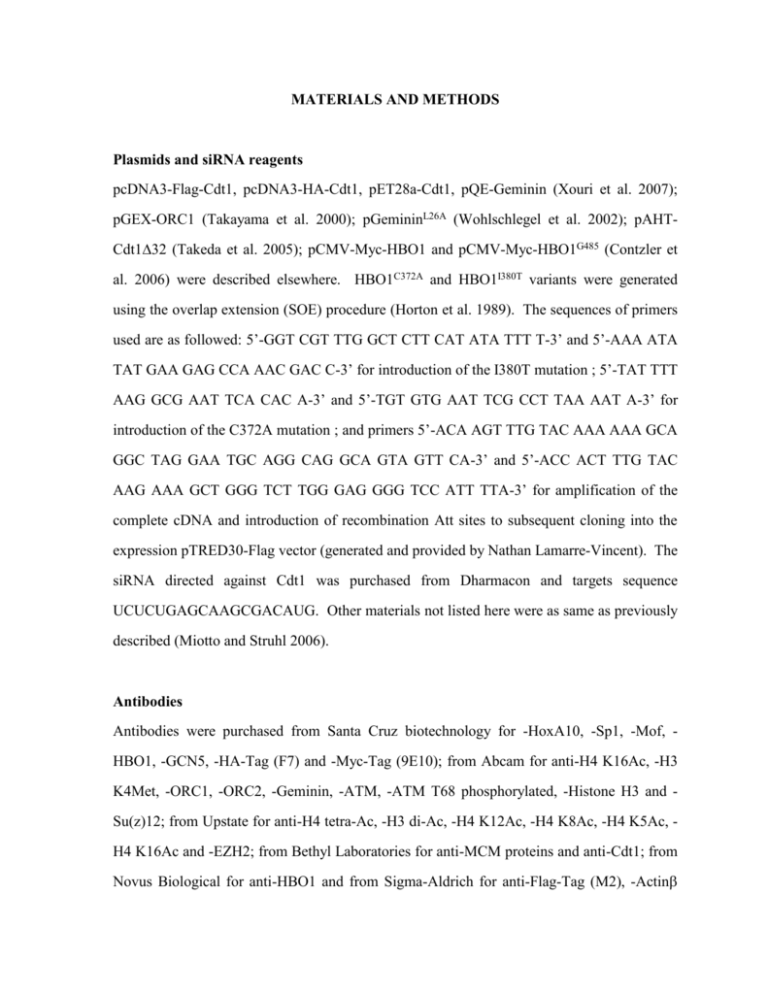
MATERIALS AND METHODS Plasmids and siRNA reagents pcDNA3-Flag-Cdt1, pcDNA3-HA-Cdt1, pET28a-Cdt1, pQE-Geminin (Xouri et al. 2007); pGEX-ORC1 (Takayama et al. 2000); pGemininL26A (Wohlschlegel et al. 2002); pAHTCdt132 (Takeda et al. 2005); pCMV-Myc-HBO1 and pCMV-Myc-HBO1G485 (Contzler et al. 2006) were described elsewhere. HBO1C372A and HBO1I380T variants were generated using the overlap extension (SOE) procedure (Horton et al. 1989). The sequences of primers used are as followed: 5’-GGT CGT TTG GCT CTT CAT ATA TTT T-3’ and 5’-AAA ATA TAT GAA GAG CCA AAC GAC C-3’ for introduction of the I380T mutation ; 5’-TAT TTT AAG GCG AAT TCA CAC A-3’ and 5’-TGT GTG AAT TCG CCT TAA AAT A-3’ for introduction of the C372A mutation ; and primers 5’-ACA AGT TTG TAC AAA AAA GCA GGC TAG GAA TGC AGG CAG GCA GTA GTT CA-3’ and 5’-ACC ACT TTG TAC AAG AAA GCT GGG TCT TGG GAG GGG TCC ATT TTA-3’ for amplification of the complete cDNA and introduction of recombination Att sites to subsequent cloning into the expression pTRED30-Flag vector (generated and provided by Nathan Lamarre-Vincent). The siRNA directed against Cdt1 was purchased from Dharmacon and targets sequence UCUCUGAGCAAGCGACAUG. Other materials not listed here were as same as previously described (Miotto and Struhl 2006). Antibodies Antibodies were purchased from Santa Cruz biotechnology for -HoxA10, -Sp1, -Mof, HBO1, -GCN5, -HA-Tag (F7) and -Myc-Tag (9E10); from Abcam for anti-H4 K16Ac, -H3 K4Met, -ORC1, -ORC2, -Geminin, -ATM, -ATM T68 phosphorylated, -Histone H3 and Su(z)12; from Upstate for anti-H4 tetra-Ac, -H3 di-Ac, -H4 K12Ac, -H4 K8Ac, -H4 K5Ac, H4 K16Ac and -EZH2; from Bethyl Laboratories for anti-MCM proteins and anti-Cdt1; from Novus Biological for anti-HBO1 and from Sigma-Aldrich for anti-Flag-Tag (M2), -Actin and -Cdc6. Protein A and protein G sepharose beads as well as control IgG-sepharose beads used in co-immunoprecipitation and ChIP assays were purchased from Amersham Biosciences. Cell culture, cell cycle synchronization and DNA damage induction HeLa and HEK293 cells were grown in Dulbecco’s modified eagle’s medium (DMEM) supplemented with 10% fetal bovine serum and adequate antibiotics. Human CCL-116 and mice lymphoblastoid cells were grown in RPMI-1640 medium supplemented with 10% serum, 2mM glutamine and antibiotics. HCT116 cells were grown in McCoy's 5a Medium Modified supplemented with 10% fetal bovine serum. To measure growth-dependent regulation of Cdt1, ORC2, MCM2 and HBO1 mRNAs and proteins expression, CCL-156 cells were arrested in the G0 phase by culture in the presence of 0.1% fetal bovine serum for 48 h (i.e. serum deprivation). For cell cycle synchronization in G1, early S phase and M phase, exponentially growing HeLa or CCL-156 cells were treated respectively with mimosine (300M for 20 h), hydroxyurea (2mM for 24 h) or nocodazole (40ng/ml for 16 h). In all cases, propidium iodide staining and flow cytometry (FACSCalibur system; Becton Dickinson) assays were used to determine the quality of the synchrony. Finally DNA damage was caused by addition of actinomycin D (2nM for 2 h) in the presence of serum (10%) to avoid complications from serum deprivation stress. Transfection of expression vectors and siRNAs constructs in human cell lines was performed using Ca3(PO4)2 co-precipitation (Miotto and Struhl 2006) or using the TfxTM-20 reagents (Promega). Significant and specific depletion was observed by western blot 48h later. Co-immunoprecipitation and in vitro pulldown assays In vivo immunoprecipitation assays were performed as previously described (Miotto and Struhl 2006). Whole cellular extract were pre-cleared at 4C using protein G sepharose 2 beads in binding buffer (150mM KCl; 20mM Tris-HCl pH 7.5; 20% glycerol; 5mM DTT) complemented with anti-protease inhibitors. Primary antibodies were coupled to protein G sepharose beads at 4C and then incubated overnight at 4C with pre-cleared cellular lysate. Washes (5 times) were carried out with the binding buffer, bound material eluted and boiled in laemmli buffer. Following electrophoresis proteins of interest were detected with adequate antibodies. To avoid false positive results, mediated by contaminating DNA during immunoprecipitation procedure, 10 g/ml ethidium bromide was added in binding and washing solutions. His-Cdt1 and His-Geminin were produced in bacteria under standard procedure. FlagHBO1 was produced in vitro using the TNT T7 Quick Coupled Transcription/Translation system (Promega). Interaction assays were conducted as previously described (Miotto and Struhl 2006). RT-PCR analysis of gene expression Extraction and purification of total RNAs from HeLa cells were performed according to manufacturer protocol with the Qiagen RNeasy columns kit with DNase I treatment (Qiagen). First-strand cDNA was synthesized using oligo(dT) and quantitative PCR in real time was performed on the resulting first-strand cDNA with primers specific to the gene of interest. Expression level of each gene in different condition was normalized to -actin expression. Primer pairs used for PCR amplification reactions are available in the Primer Bank (Wang and Seed 2003). Cellular and chromatin fractionation Cells (2x107) were scraped in ice-cold PBS (Sibani et al. 2005). After centrifugation, they were re-suspended in lysis buffer (10mM HEPES pH 7.9; 100mM NaCl; 300mM Sucrose; 0.1% triton X-100) containing adequate protease inhibitors (Roche) and incubated on ice for 10 minutes. After centrifugation at 1000 rpm for 5 minutes the pellet was washed twice in 3 the same buffer. Cell remnants were then re-suspended in extraction buffer (100mM HEPES pH 7.9; 200mM NaCl; 300mM sucrose; 0.1% triton X-100; 5mM MgCl2 containing 100 units of DNAse I (Promega). Following incubation at 25C for 30 minutes the DNA bound proteins (soluble) and the nuclear matrix bound protein (insoluble) were isolated by centrifugation at 2500 rpm for 5 minutes. The insoluble fraction that also contains nucleaseresistant chromatin was used to access the partitioning of licensing factors MCM, Cdt1, Cdc6 and ORC in HBO1 depleted cells as well as in cells staged at specific phase of the cycle. The behavior of MCM, ORC and Cdt1 proteins in chromatin fractions prepared from staged cells indicates an efficient and qualitative biochemical fractionation with this procedure. Western blot analysis of acid-extracted histones modifications Histones were acid-extracted according to manufacturer procedure (Santa Cruz Biotechnology). After re-suspension, protein concentration was access by Bradford dosage to ensure equal loading. Impact of HBO1 depletion on histone H2AX, H4, and H3 posttranslational modifications was then detected with appropriate antibodies. Chromatin immunoprecipitation (ChIP) assays ChIP assays were performed as previously described (Cawley et al. 2004). Briefly, 2x108 asynchronously growing cells were treated with formaldehyde to 1% final concentration to create protein-DNA crosslinks, and the crosslinked chromatins were extracted in Run-onLysis buffer (10mM Tris-HCl pH 7.5; 10mM NaCl; 3mM MgCl2; 0.5% NP-40) and then both digested with 100U of micrococcal nuclease and sheared by sonication (Misonix Sonicator 3000) on ice to an average length of 500bp. After pre-cleared with a mix of protein A/G sepharose beads (4C for 3 hours), the chromatin from an equivalent of 5x107 cells was used for immunoprecipitation with appropriate antibodies or IgG as a control. After 4C overnight incubation, beads were washed, eluted in buffer E (25mM Tris-HCl pH 7.5; 5mM EDTA; 0.5% SDS) and cross-links reversed at 65C with proteinase K for 6 hours. Resulting 4 naked DNAs were then purified using the QIAquick PCR purification kit (Qiagen) and DNA eluted in 100l distilled water. Sequential ChIP analysis was performed essentially as described previously (Geisberg and Struhl 2004). Chromatin-bound material after the first IP was heat-eluted 20 minutes at 65C in buffer E as state before; eluted-solution was adjusted to 150mM NaCl, 0.1% Triton X-100 and second IP performed overnight at 4C. DNA is then purified as described above. Real time PCR analysis of ChIP DNA fragments Quantitative real-time PCR was performed using SYBR Green I. Enrichment for a specific DNA sequence was calculated using the comparative Ct method as previously described (Cawley et al. 2004). Data are normalized to histone H3 exon 2 background binding and expressed as occupancy value (occupancy). In the case of post-translational modifications of histones occupancy data are further normalized to histone H3 density and therefore expressed as fold over H3 (fold/H3). Experiments were performed in triplicate. PCR primer pairs are available on request. Immunofluorescence and flow cytometry analysis BrdU incorporation test were performed as previously described (BD biosciences online protocol). Quickly, asynchronous HeLa cells attached to cover slips were pulse-labeled for 45 minutes with 100µM BrdU at 37C (Sigma-aldrich). Cells were subsequently washed with PBS and fixed in 80% chilled ethanol for 20 minutes. Ethanol-fixed cells were rehydrated by washes in PBS and a second step of fixation in freshly made 4N HCl was performed for 20 minutes at room temperature. BrdU incorporation was then detected in a two-step process with a primary anti-BrdU (Abcam) antibody and a secondary FITC-coupled antibody (Jackson ImmunoResearch). Under microscope, the pourcentage of the total number of cells synthesizing DNA (i.e. BrdU stained) was determined on random fields for a total of ~1000 nuclei scored for each condition. 5 Flow cytometry analyses were performed under standard procedure. The cell pellet was resuspended in 0.5% paraformaldehyde for 10 minutes to retain GFP fluorescence (i.e. as a control of transfection) before ethanol treatment. Cells were stained with 20g/ml propidium iodide (Sigma) in presence of 50g/ml of RNase H for 30 minutes at room temperature in the 1x106 GFP-fluorescent positive cells were dark and extensively washed in PBS. subsequently analyzed for each condition using a FACSCalibur flow cytometer and data were processed using the CellQuest software (Becton Dickinson). Statistical analyses To determine statistical significance a student t-test for comparison of two different groups was performed. P<0.05, *, was considered significant. REFERENCES Cawley, S., Bekiranov, S., Ng, H.H., Kapranov, P., Sekinger, E.A., Kampa, D., Piccolboni, A., Sementchenko, V., Cheng, J., Williams, A.J., Wheeler, R., Wong, B., Drenkow, J., Yamanaka, M., Patel, S., Brubaker, S., Tammana, H., Helt, G., Struhl, K., and Gingeras, T.R. 2004. Unbiased mapping of transcription factor binding sites along human chromosomes 21 and 22 points to widespread regulation of noncoding RNAs. Cell 116(4): 499-509. Contzler, R., Regamey, A., Favre, B., Roger, T., Hohl, D., and Huber, M. 2006. Histone acetyltransferase HBO1 inhibits NF-kappaB activity by coactivator sequestration. Biochem Biophys Res Commun 350(1): 208-213. Geisberg, J.V. and Struhl, K. 2004. Quantitative sequential chromatin immunoprecipitation, a method for analyzing co-occupancy of proteins at genomic regions in vivo. Nucl Acids Res 32: e151. 6 Horton, R.M., Hunt, H.D., Ho, S.N., Pullen, J.K., and Pease, L.R. 1989. Engineering hybrid genes without the use of restriction enzymes: gene splicing by overlap extension. Gene 77(1): 61-68. Miotto, B. and Struhl, K. 2006. Differential gene regulation by selective association of transcriptional coactivators and bZIP DNA-binding domains. Mol Cell Biol 26(16): 5969-5982. Sibani, S., Price, G.B., and Zannis-Hadjopoulos, M. 2005. Decreased origin usage and initiation of DNA replication in haploinsufficient HCT116 Ku80+/- cells. J Cell Sci 118(Pt 15): 3247-3261. Takayama, M.A., Taira, T., Tamai, K., Iguchi-Ariga, S.M., and Ariga, H. 2000. ORC1 interacts with c-Myc to inhibit E-box-dependent transcription by abrogating c-MycSNF5/INI1 interaction. Genes Cells 5(6): 481-490. Takeda, D.Y., Parvin, J.D., and Dutta, A. 2005. Degradation of Cdt1 during S phase is Skp2independent and is required for efficient progression of mammalian cells through S phase. J Biol Chem 280(24): 23416-23423. Wang, X. and Seed, B. 2003. A PCR primer bank for quantitative gene expression analysis. Nucleic Acids Res 31(24): e154. Wohlschlegel, J.A., Kutok, J.L., Weng, A.P., and Dutta, A. 2002. Expression of geminin as a marker of cell proliferation in normal tissues and malignancies. Am J Pathol 161(1): 267-273. Xouri, G., Squire, A., Dimaki, M., Geverts, B., Verveer, P.J., Taraviras, S., Nishitani, H., Houtsmuller, A.B., Bastiaens, P.I., and Lygerou, Z. 2007. Cdt1 associates dynamically with chromatin throughout G1 and recruits Geminin onto chromatin. Embo J 26(5): 1303-1314. 7
